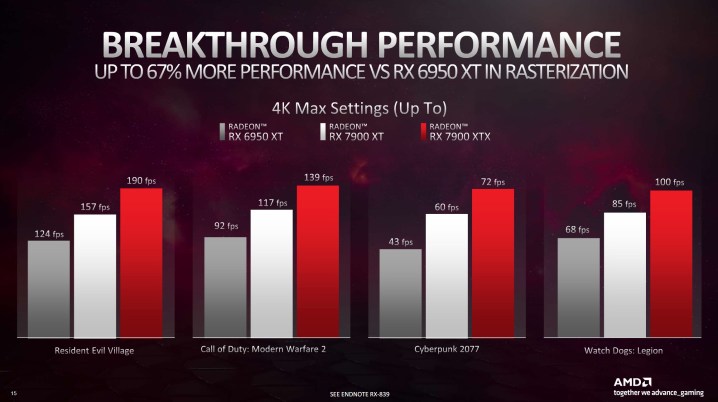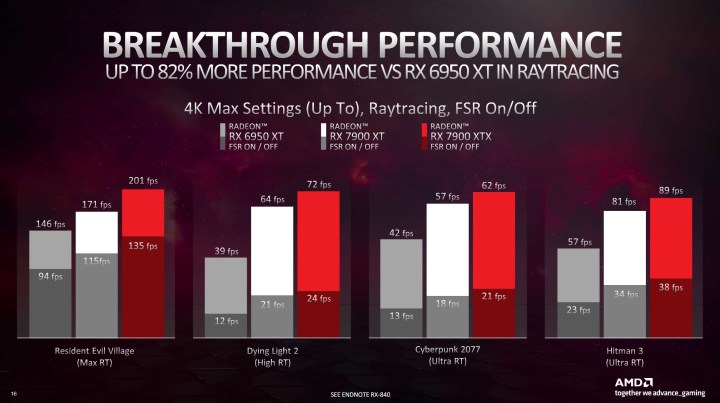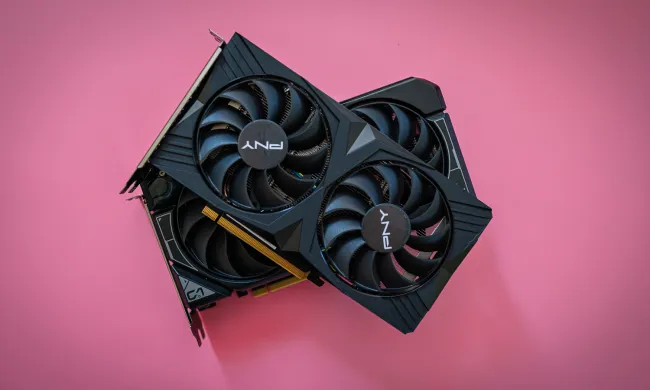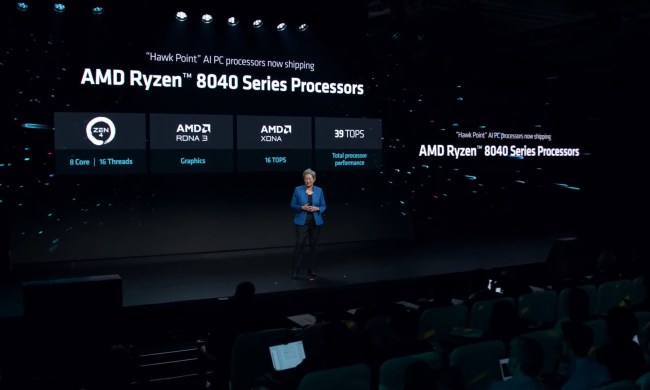AMD was light on performance data when it announced its upcoming RX 7900 XTX graphics card a couple of weeks back. It wasn’t that AMD didn’t share numbers — the presentation was packed with them — but that they were all from uncommon resolutions, esports titles that don’t stress the best graphics cards, or veiled by FidelityFX Super Resolution (FSR) upscaling. AMD is finally ready to share more information, giving us a better idea of how the new flagship will stack up — and there’s good and bad news.
The company shared performance data for the RX 7900 XTX and RX 7900 XT in four games: Resident Evil Village, Call of Duty Modern Warfare 2, Cyberpunk 2077, and Watch Dogs: Legion. The data suggests the RX 7900 XTX could be competitive with even the Nvidia RTX 4090 in some titles. But the RX 7900 XT, despite being close in price to the flagship model, shows a wide performance gap.

Starting with the RTX 4090 comparison, AMD’s data suggests the RX 7900 XTX will be about 10% to 15% slower than the Nvidia flagship. The only data we have a direct comparison for is Cyberpunk 2077, where the RTX 4090 reached 78 frames per second (fps) in our testing. The RX 7900 XTX reached 72 fps based on AMD’s data — about 8% slower. It’s a loss, but the RX 7900 XTX is also $600 cheaper than the RTX 4090.
Although it’s important to wait for third-party testing, we have no reason to think AMD’s results are misrepresentative. In Cyberpunk 2077, we recorded almost the same result with the RX 6950 XT that AMD published. If AMD’s numbers are accurate, the RX 7900 XTX could offer somewhere around a 70% increase over the RX 6950 XT.
That’s exciting, but AMD’s data also comes mixed with disappointment. The RX 7900 XT, which is only $100 cheaper than the RX 7900 XTX, shows a performance gap of about 17% compared to the flagship card. It’s still far above AMD’s best GPU from the previous generation, but it looks like the XTX is shaping up to be the better buy.

Ray tracing performance is also a little disappointing. AMD talked up the improvements it made with ray tracing during the RX 7900 XTX announcement. The previous generation struggled with ray tracing compared to the competition from Nvidia. AMD’s numbers suggest that, although there is an improvement, AMD won’t be able to go toe-to-toe with Team Green.
In Cyberpunk 2077 with its Ultra RT preset, AMD said the RX 7900 XTX reached an average of 21 fps without FSR turned on. The RTX 4090 reached nearly 43 fps at this preset based on our testing. AMD’s numbers show that the RX 7900 XTX may be able to compete with the RTX 3090 Ti in ray tracing performance, though, which is a hopeful sign.
Although AMD’s new batch of benchmarks don’t show dominating performance across the board, they’re still impressive when compared against the competition from Nvidia. The main question is how the RX 7900 XTX will stack up to the RTX 4080, as only $200 separates these two high-end GPUs.
For now, all we can do is wait until the RX 7900 XTX and RX 7900 XT launch on December 13. We have no reason to think AMD’s numbers are off, but it’s still important to view first-party benchmarks with skepticism until independent reviews are out.




